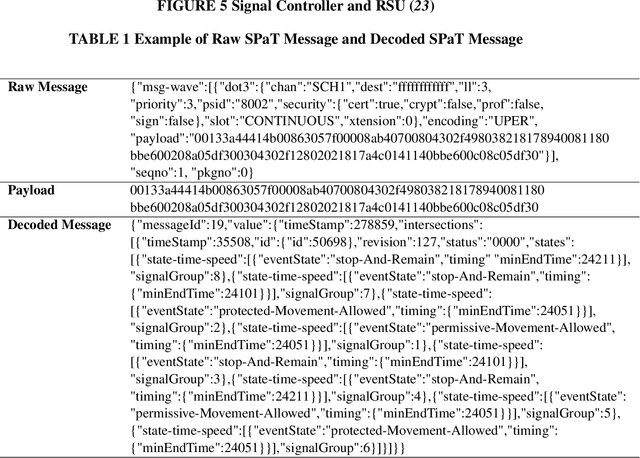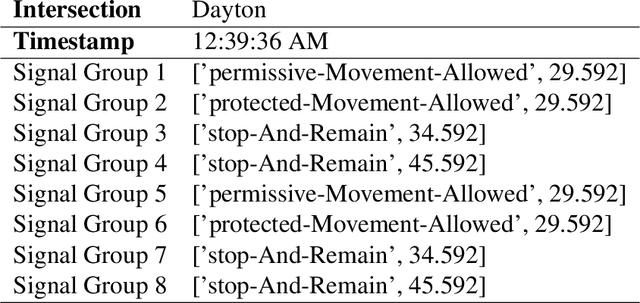Bin Ran
Planning Safety Trajectories with Dual-Phase, Physics-Informed, and Transportation Knowledge-Driven Large Language Models
Apr 06, 2025Abstract:Foundation models have demonstrated strong reasoning and generalization capabilities in driving-related tasks, including scene understanding, planning, and control. However, they still face challenges in hallucinations, uncertainty, and long inference latency. While existing foundation models have general knowledge of avoiding collisions, they often lack transportation-specific safety knowledge. To overcome these limitations, we introduce LetsPi, a physics-informed, dual-phase, knowledge-driven framework for safe, human-like trajectory planning. To prevent hallucinations and minimize uncertainty, this hybrid framework integrates Large Language Model (LLM) reasoning with physics-informed social force dynamics. LetsPi leverages the LLM to analyze driving scenes and historical information, providing appropriate parameters and target destinations (goals) for the social force model, which then generates the future trajectory. Moreover, the dual-phase architecture balances reasoning and computational efficiency through its Memory Collection phase and Fast Inference phase. The Memory Collection phase leverages the physics-informed LLM to process and refine planning results through reasoning, reflection, and memory modules, storing safe, high-quality driving experiences in a memory bank. Surrogate safety measures and physics-informed prompt techniques are introduced to enhance the LLM's knowledge of transportation safety and physical force, respectively. The Fast Inference phase extracts similar driving experiences as few-shot examples for new scenarios, while simplifying input-output requirements to enable rapid trajectory planning without compromising safety. Extensive experiments using the HighD dataset demonstrate that LetsPi outperforms baseline models across five safety metrics.See PDF for project Github link.
V2X-LLM: Enhancing V2X Integration and Understanding in Connected Vehicle Corridors
Mar 04, 2025Abstract:The advancement of Connected and Automated Vehicles (CAVs) and Vehicle-to-Everything (V2X) offers significant potential for enhancing transportation safety, mobility, and sustainability. However, the integration and analysis of the diverse and voluminous V2X data, including Basic Safety Messages (BSMs) and Signal Phase and Timing (SPaT) data, present substantial challenges, especially on Connected Vehicle Corridors. These challenges include managing large data volumes, ensuring real-time data integration, and understanding complex traffic scenarios. Although these projects have developed an advanced CAV data pipeline that enables real-time communication between vehicles, infrastructure, and other road users for managing connected vehicle and roadside unit (RSU) data, significant hurdles in data comprehension and real-time scenario analysis and reasoning persist. To address these issues, we introduce the V2X-LLM framework, a novel enhancement to the existing CV data pipeline. V2X-LLM leverages Large Language Models (LLMs) to improve the understanding and real-time analysis of V2X data. The framework includes four key tasks: Scenario Explanation, offering detailed narratives of traffic conditions; V2X Data Description, detailing vehicle and infrastructure statuses; State Prediction, forecasting future traffic states; and Navigation Advisory, providing optimized routing instructions. By integrating LLM-driven reasoning with V2X data within the data pipeline, the V2X-LLM framework offers real-time feedback and decision support for traffic management. This integration enhances the accuracy of traffic analysis, safety, and traffic optimization. Demonstrations in a real-world urban corridor highlight the framework's potential to advance intelligent transportation systems.
FollowGen: A Scaled Noise Conditional Diffusion Model for Car-Following Trajectory Prediction
Nov 23, 2024



Abstract:Vehicle trajectory prediction is crucial for advancing autonomous driving and advanced driver assistance systems (ADAS). Although deep learning-based approaches - especially those utilizing transformer-based and generative models - have markedly improved prediction accuracy by capturing complex, non-linear patterns in vehicle dynamics and traffic interactions, they frequently overlook detailed car-following behaviors and the inter-vehicle interactions critical for real-world driving applications, particularly in fully autonomous or mixed traffic scenarios. To address the issue, this study introduces a scaled noise conditional diffusion model for car-following trajectory prediction, which integrates detailed inter-vehicular interactions and car-following dynamics into a generative framework, improving both the accuracy and plausibility of predicted trajectories. The model utilizes a novel pipeline to capture historical vehicle dynamics by scaling noise with encoded historical features within the diffusion process. Particularly, it employs a cross-attention-based transformer architecture to model intricate inter-vehicle dependencies, effectively guiding the denoising process and enhancing prediction accuracy. Experimental results on diverse real-world driving scenarios demonstrate the state-of-the-art performance and robustness of the proposed method.
Real-World Data Inspired Interactive Connected Traffic Scenario Generation
Sep 25, 2024



Abstract:Simulation is a crucial step in ensuring accurate, efficient, and realistic Connected and Autonomous Vehicles (CAVs) testing and validation. As the adoption of CAV accelerates, the integration of real-world data into simulation environments becomes increasingly critical. Among various technologies utilized by CAVs, Vehicle-to-Everything (V2X) communication plays a crucial role in ensuring a seamless transmission of information between CAVs, infrastructure, and other road users. However, most existing studies have focused on developing and testing communication protocols, resource allocation strategies, and data dissemination techniques in V2X. There is a gap where real-world V2X data is integrated into simulations to generate diverse and high-fidelity traffic scenarios. To fulfill this research gap, we leverage real-world Signal Phase and Timing (SPaT) data from Roadside Units (RSUs) to enhance the fidelity of CAV simulations. Moreover, we developed an algorithm that enables Autonomous Vehicles (AVs) to respond dynamically to real-time traffic signal data, simulating realistic V2X communication scenarios. Such high-fidelity simulation environments can generate multimodal data, including trajectory, semantic camera, depth camera, and bird's eye view data for various traffic scenarios. The generated scenarios and data provide invaluable insights into AVs' interactions with traffic infrastructure and other road users. This work aims to bridge the gap between theoretical research and practical deployment of CAVs, facilitating the development of smarter and safer transportation systems.
Hypergraph-based Motion Generation with Multi-modal Interaction Relational Reasoning
Sep 18, 2024Abstract:The intricate nature of real-world driving environments, characterized by dynamic and diverse interactions among multiple vehicles and their possible future states, presents considerable challenges in accurately predicting the motion states of vehicles and handling the uncertainty inherent in the predictions. Addressing these challenges requires comprehensive modeling and reasoning to capture the implicit relations among vehicles and the corresponding diverse behaviors. This research introduces an integrated framework for autonomous vehicles (AVs) motion prediction to address these complexities, utilizing a novel Relational Hypergraph Interaction-informed Neural mOtion generator (RHINO). RHINO leverages hypergraph-based relational reasoning by integrating a multi-scale hypergraph neural network to model group-wise interactions among multiple vehicles and their multi-modal driving behaviors, thereby enhancing motion prediction accuracy and reliability. Experimental validation using real-world datasets demonstrates the superior performance of this framework in improving predictive accuracy and fostering socially aware automated driving in dynamic traffic scenarios.
V2X-VLM: End-to-End V2X Cooperative Autonomous Driving Through Large Vision-Language Models
Aug 17, 2024Abstract:Advancements in autonomous driving have increasingly focused on end-to-end (E2E) systems that manage the full spectrum of driving tasks, from environmental perception to vehicle navigation and control. This paper introduces V2X-VLM, an innovative E2E vehicle-infrastructure cooperative autonomous driving (VICAD) framework with large vision-language models (VLMs). V2X-VLM is designed to enhance situational awareness, decision-making, and ultimate trajectory planning by integrating data from vehicle-mounted cameras, infrastructure sensors, and textual information. The strength of the comprehensive multimodel data fusion of the VLM enables precise and safe E2E trajectory planning in complex and dynamic driving scenarios. Validation on the DAIR-V2X dataset demonstrates that V2X-VLM outperforms existing state-of-the-art methods in cooperative autonomous driving.
Crossfusor: A Cross-Attention Transformer Enhanced Conditional Diffusion Model for Car-Following Trajectory Prediction
Jun 17, 2024Abstract:Vehicle trajectory prediction is crucial for advancing autonomous driving and advanced driver assistance systems (ADAS), enhancing road safety and traffic efficiency. While traditional methods have laid foundational work, modern deep learning techniques, particularly transformer-based models and generative approaches, have significantly improved prediction accuracy by capturing complex and non-linear patterns in vehicle motion and traffic interactions. However, these models often overlook the detailed car-following behaviors and inter-vehicle interactions essential for real-world driving scenarios. This study introduces a Cross-Attention Transformer Enhanced Conditional Diffusion Model (Crossfusor) specifically designed for car-following trajectory prediction. Crossfusor integrates detailed inter-vehicular interactions and car-following dynamics into a robust diffusion framework, improving both the accuracy and realism of predicted trajectories. The model leverages a novel temporal feature encoding framework combining GRU, location-based attention mechanisms, and Fourier embedding to capture historical vehicle dynamics. It employs noise scaled by these encoded historical features in the forward diffusion process, and uses a cross-attention transformer to model intricate inter-vehicle dependencies in the reverse denoising process. Experimental results on the NGSIM dataset demonstrate that Crossfusor outperforms state-of-the-art models, particularly in long-term predictions, showcasing its potential for enhancing the predictive capabilities of autonomous driving systems.
Truck Parking Usage Prediction with Decomposed Graph Neural Networks
Jan 23, 2024Abstract:Truck parking on freight corridors faces various challenges, such as insufficient parking spaces and compliance with Hour-of-Service (HOS) regulations. These constraints often result in unauthorized parking practices, causing safety concerns. To enhance the safety of freight operations, providing accurate parking usage prediction proves to be a cost-effective solution. Despite the existing research demonstrating satisfactory accuracy for predicting individual truck parking site usage, few approaches have been proposed for predicting usage with spatial dependencies of multiple truck parking sites. We present the Regional Temporal Graph Neural Network (RegT-GCN) as a predictive framework for assessing parking usage across the entire state to provide better truck parking information and mitigate unauthorized parking. The framework leverages the topological structures of truck parking site distributions and historical parking data to predict occupancy rates across a state. To achieve this, we introduce a Regional Decomposition approach, which effectively captures the geographical characteristics. We also introduce the spatial module working efficiently with the temporal module. Evaluation results demonstrate that the proposed model surpasses other baseline models, improving the performance by more than $20\%$ compared with the original model. The proposed model allows truck parking sites' percipience of the topological structures and provides higher performance.
Optimizing Bus Travel: A Novel Approach to Feature Mining with P-KMEANS and P-LDA Algorithms
Dec 04, 2023Abstract:Customizing services for bus travel can bolster its attractiveness, optimize usage, alleviate traffic congestion, and diminish carbon emissions. This potential is realized by harnessing recent advancements in positioning communication facilities, the Internet of Things, and artificial intelligence for feature mining in public transportation. However, the inherent complexities of disorganized and unstructured public transportation data introduce substantial challenges to travel feature extraction. This study presents a bus travel feature extraction method rooted in Point of Interest (POI) data, employing enhanced P-KMENAS and P-LDA algorithms to overcome these limitations. While the KMEANS algorithm adeptly segments passenger travel paths into distinct clusters, its outcomes can be influenced by the initial K value. On the other hand, Latent Dirichlet Allocation (LDA) excels at feature identification and probabilistic interpretations yet encounters difficulties with feature intermingling and nuanced sub-feature interactions. Incorporating the POI dimension enhances our understanding of travel behavior, aligning it more closely with passenger attributes and facilitating easier data analysis. By incorporating POI data, our refined P-KMENAS and P-LDA algorithms grant a holistic insight into travel behaviors and attributes, effectively mitigating the limitations above. Consequently, this POI-centric algorithm effectively amalgamates diverse POI attributes, delineates varied travel contexts, and imparts probabilistic metrics to feature properties. Our method successfully mines the diverse aspects of bus travel, such as age, occupation, gender, sports, cost, safety, and personality traits. It effectively calculates relationships between individual travel behaviors and assigns explanatory and evaluative probabilities to POI labels, thereby enhancing bus travel optimization.
Exploring Driving Behavior for Autonomous Vehicles Based on Gramian Angular Field Vision Transformer
Oct 21, 2023Abstract:Effective classification of autonomous vehicle (AV) driving behavior emerges as a critical area for diagnosing AV operation faults, enhancing autonomous driving algorithms, and reducing accident rates. This paper presents the Gramian Angular Field Vision Transformer (GAF-ViT) model, designed to analyze AV driving behavior. The proposed GAF-ViT model consists of three key components: GAF Transformer Module, Channel Attention Module, and Multi-Channel ViT Module. These modules collectively convert representative sequences of multivariate behavior into multi-channel images and employ image recognition techniques for behavior classification. A channel attention mechanism is applied to multi-channel images to discern the impact of various driving behavior features. Experimental evaluation on the Waymo Open Dataset of trajectories demonstrates that the proposed model achieves state-of-the-art performance. Furthermore, an ablation study effectively substantiates the efficacy of individual modules within the model.
 Add to Chrome
Add to Chrome Add to Firefox
Add to Firefox Add to Edge
Add to Edge